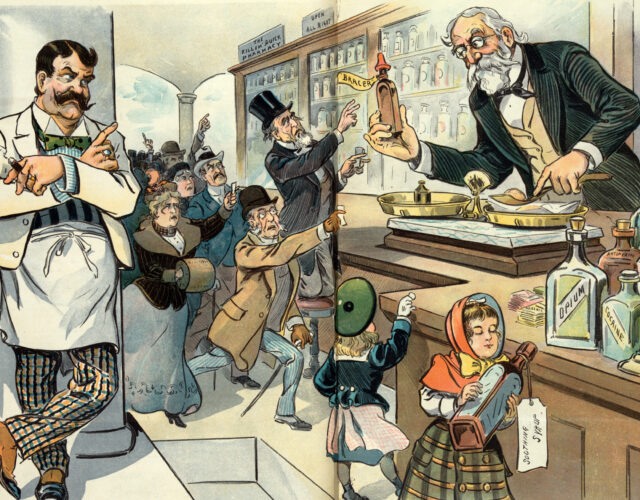James C. Whorton. The Arsenic Century: How Victorian Britain Was Poisoned at Home, Work, and Play. Oxford University Press, 2010. 412 pp. $19.
In Victorian Britain grocery stores sold tea, biscuits, sugar, flour, rice, and arsenic. Unregulated for much of the 19th century, arsenic was available to everyone, including the young and the murderous. The book’s title, The Arsenic Century: How Victorian Britain Was Poisoned at Home, Work, and Play, neatly sums up both the content of James C. Whorton’s book and the ubiquity of arsenic in everyday life. And for those who might think that arsenic was a peculiarly British problem, Whorton makes clear that the United States faced exactly the same issues as did Britain.
Wallpaper, beer, wine, sweets, wrapping paper, painted toys, sheep dip, insecticides, clothing, dead bodies, stuffed animals, hat ornaments, coal, and candles—all contained arsenic. There was even arsenic in medicine (often deliberately prescribed by doctors). But this book is far from a litany of deliberate and accidental poisonings; Whorton is a storyteller who uses his true tales to show the role arsenic played in such varied areas as laissez-faire economics and the development of forensic toxicology. On one level this book is a racy account of human frailty, greed, and ignorance; on another it is a deeply serious attempt to set in context our own environmental issues. Whorton writes, “The infiltration of arsenic into 19th-century domestic life was the template for pollution in the modern industrial world, the pilot episode, if you will, for a series of dramas of environmental poisoning that has no end in sight.”
If any one event can be blamed for arsenic’s ubiquity, it’s the Industrial Revolution. Arsenical compounds had been used since ancient times in pigments and medicines. Such compounds are common in mineral ores and in coal, both building blocks of the Industrial Revolution. Smelting and burning liberated elemental arsenic, which then combined with oxygen to produce arsenious acid or white arsenic (As2O3), now known as arsenic trioxide. This waste product was sold cheaply and found its way into myriad products: candle makers used it to create inexpensive tallow candles that burned as well as wax ones; housewives used it to poison vermin; doctors used it to maintain bodies for later dissection; and taxidermists used it to preserve specimens. Those who desired brilliant and permanent greens in their clothing, paints, and candy turned to such arsenical pigments as Scheele’s green (copper arsenite). And, of course, men and women used it to get away with murder.
White arsenic—simply called arsenic—was the poisoner’s first choice owing to its easy accessibility and its mimicry of the common gastrointestinal illnesses of the day, including cholera. Poverty-stricken parents used arsenic to rid themselves of excess children; wives used it against husbands and husbands against wives; children used it against parents. The new life-insurance industry added to the temptation: one woman, Mary Ann Cotton, murdered her mother, three husbands, a fiancé, and many of her 15 children and stepchildren for insurance payouts. Given in small quantities over a period of time, arsenic produced a gradual decline in the health of the sufferer and symptoms easily attributable to natural illnesses. To confirm arsenic as the cause of death required not only autopsies but knowledge of how arsenic acted in the body along with reliable methods to detect it in organic matter. In 1814 Mateu Orfila published the first textbook on toxicology; in 1836 chemist James Marsh developed the Marsh test, which could identify minuscule amounts of arsenic in food and in human remains; in 1841 Hugo Reinsch developed a simple test for arsenic using water, hydrochloric acid, and copper foil. Cotton was sentenced to death in 1873 based on this newly established body of chemical knowledge.
Most poisonings, though, were accidental. Unless clearly labeled and kept separate, the white powder was easily mistaken for plaster of Paris (used by candy makers to adulterate sugar), flour, or sugar. Individuals unwittingly added arsenic to food or drink, as did manufacturers. And no one suspected that green dresses or green wallpaper might sicken and even kill until a doctor sounded the alarm in 1857. While wallpaper manufacturers claimed their arsenical paper was safe and questioned any evidence against them, chemists and doctors grappled with the existence of chronic low-level poisoning from nonfood sources. Since doctors prescribed small doses of arsenic as a medicine, many believed that tiny doses would not cause sickness. Not until the 1880s, as the number of clinical histories mounted, did a consensus emerge: arsenic at any dose was unhealthy.
If this book has any heroes, it’s the toxicologists and doctors who tracked the poison to its source, whether in cases of murder or environmental poisoning, and who agitated for laws restricting arsenic’s availability. The arsenic conflict between public welfare and private enterprise generally pitted reforming doctors and chemists against government and manufacturers, with the former often losing to laissez-faire principles. In the end it was consumer revulsion at being deliberately poisoned rather than legislation that forced manufacturers to produce arsenic-free products.
Whorton’s concern breaks through in the occasional passages where he compares past and present responses to proposed legislation. Then (regarding arsenic): “‘It was not an advantageous proceeding,’ one opponent thundered, ‘to treat the people of this country like children.’” Now (regarding trans fats): “There is solid resistance from those who deplore governmental interference with private enterprise [for example]: ‘I can’t believe that there are people dumb enough to support such an intrusion into personal choice.’ ” Of greater present concern to Whorton are new synthetic products entering our environment—products whose long-term effects cannot be clearly predicted. He writes, “As with arsenical candles and papers and fabrics, these items will become established in commerce before their dangers are recognized, ensuring that any attempt to curtail their use will be resisted by manufacturers . . . and fought or ignored by politicians ideologically opposed to government interference with business.” When science met the marketplace in the 19th century, politics ruled. Whorton fears that the 21st century will be little different.




